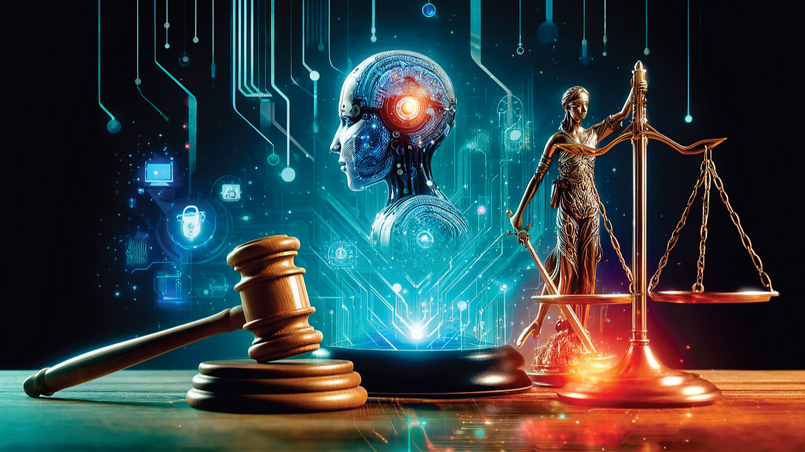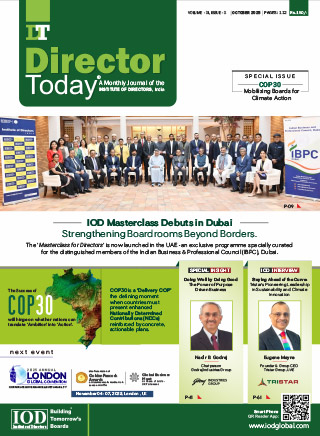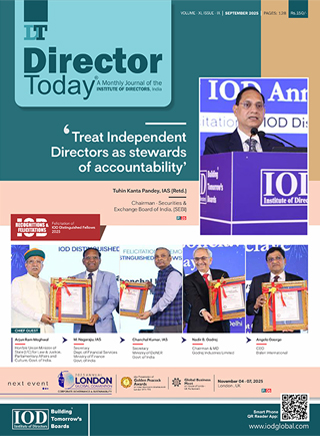Artificial Intelligence and Boardroom Strategies : Ensuring Holistic Focus on Corporate Priorities and Collective Survival

Ensuring Holistic Focus on Corporate Priorities and Collective Survival
AI is not new. Certain AI environments and workstations in the 1980s complemented and supported human capabilities by flagging up links, patterns and relationships across various aspects of a user's work and thinking. They had certain advantages over today's more generally available tools and models trained with selected data sets and seemed to involve fewer cyber and other risks. My early books such as Transforming the Company and work as the world's first professor of corporate transformation suggested digital technologies would quickly enable more flexible and responsive organisation and business models.
Initial and Contemporary Perceptions of AI
The 1980s vision was of bureaucratic and hierarchical organisations that had to be periodically restructured or re-engineered being replaced by flexible networks of relationships that could organically grow, learn and quickly expand or contract to suit changing market conditions and new ways of working. It seemed realisable, using personalised technology that complemented how I thought and operated and sometimes seemed almost part of myself. Yet despite successive waves of management fads and technology, aspects of last century's organisations persist.
Today's AI tools seem very different from those used at Xerox PARC. They are generally available, being rapidly adopted and continue to evolve. There are differing views on the risks and existential threat they pose and to what extent and how they should be regulated. President Trump in support of major US technology companies is seeking to reduce regulatory constraints on the adoption and use of AI. The ending of enforcement of US anti-bribery legislation widens the ways in which the technology may be pushed. Coping with AI and data centre needs for energy, water and rare minerals is now a major challenge.
AI, Global Risks and Existential Threats
Such is the hype and attention given to AI that some enthusiasts suggest effective AI governance requires a separate AI risk committee, just as an IT director might advocate a cyber-risk committee. Both cyber espionage and warfare and adverse outcomes of AI technologies are ranked by the World Economic Forum in the top 10 global risks over the next 10 years in terms of impact. AI also appears in listings of challenges alongside biosecurity, nuclear, biodiversity, climate change and other existential threats.
Importantly, global risks and existential threats are inter-related. They can influence and accentuate or accelerate each other. The experience of dealing with Covid 19 suggests few communities, companies, governments and/or societies could cope with a combination of them occurring simultaneously. AI is especially dangerous. Its potential applications lures and it is accessible to bad actors. It can be weaponised and used to overcome cyber defences and/or to speed up the development of biological, chemical and other weapons.

AI Governance and Avoiding Fragmentation
Boards need a holistic overview of the inter-related risks and threats facing an entity and looming in the contexts within which it operates. Allocating responsibilities for addressing them to different committees, can result in fragmentation, their inter-relation being missed, confusion about who is accountable, and action not being taken by those who think something is the responsibility of another person or group. Some issues may fall into the voids between individual and departmental responsibilities.
A single risk committee can provide a holistic overview of all risks and threats and their evolution and inter-action. Fragmentation may lead to slowburn but looming crises and cross departmental, cross functional, inter organisational, national and collective responses being over-looked or ignored. Directors and boards need relevant, timely and actionable advice and guidance on what to do from the perspective of a total organisation, rather than knowledge about selected aspects of problems from a functional and/or discipline viewpoint.
AI Dependency and Business Continuity
In many companies the focus of effort and skills within teams relates to what needs to be done to ensure compliance with multiple and often differing regulatory provisions, frameworks and corporate reporting requirements, and avoid fines and penalties for responsible directors. Less attention may be given to possible events with potentially catastrophic consequences, but whose timing and tipping points are uncertain and likelihood of occurring in the short term is considered low, or how to cope with and recover from them.
Many companies are increasingly dependent upon AI and the digital and other infrastructures that support them and unprepared for their unavailability. They are at risk and vulnerable in various ways, ranging from solar flares to cable cutting by dragging an anchor along the seabed. They are often poorly protected. Geopolitical opponents as well as bad actors are likely to be aware of the vulnerabilities of critical infrastructures. They may scout them and subject them to cyber or other attacks. Many businesses would struggle to operate without access to the internet, their networks and cloud services, and survive in an analogue world.
Many companies are increasingly dependent upon AI and the digital and other infrastructures that support them and unprepared for their unavailability. They are at risk and vulnerable in various ways, ranging from solar flares to cable cutting by dragging an anchor along the seabed.
AI Access and Exclusion
While some people may be at risk of losing the infrastructure that supports AI and digital services, others and communities where a company operates may never have had them. In the rarified atmosphere of a head office and surrounded by a supporting team equipped with the latest technology, one may forget that it might not be available to many customers and prospects. Unequal access to AI and other technology can isolate and marginalise certain groups and sections of the population. The cost of upgrading infrastructures, cabling and cooling data centres, and strain on energy supplies and resources, can be considerable.
Balancing Strategic and Trivial Uses of AI
When there are bandwidth and resource constraints, technology vendors and businesses are usually keen to make money by quickly building a large customer base. What is available may be used for trivial purposes rather than something more important for our collective survival such as confronting an existential threat. A limited band around the earth is suitable for satellite use. It could become unavailable if an impact with space debris leads to a chain reaction of further collisions. Over 70% of satellite capacity has been used for TV and video.
Rather than wait for the development of AI applications that might help with earth system, environment, climate and weather monitoring, and our collective responses to various threats, accessible tools have been rushed into the marketplace. Available energy, water and mineral resources are again being devoted to a wide range of purposes that could be considered non-essential or even indulgent compared with helping humankind to continue to exist.
Prioritising Contending Requirements
Directors and boards should also consider whether initial and early AI applications should be concerned with overhead activities or areas that are critical for corporate success. People they meet in overhead roles and head office C-suites may lobby for resources to be devoted to areas concerned with consequences of an organisation's existence, such as legal, regulatory, compliance and reporting requirements. They may be cocooned from less visible people in the front line and in direct contact with customers and experiencing the marketplace.
The outputs of many AI applications are not visible to customers or differentiators. Many organisations have significant numbers of people in roles that are largely concerned with enabling and supporting the corporate bureaucracy, obligations to regulators and legal and/or reporting requirements. Fewer may be involved in mission critical areas such as competitive bidding and winning business, building customer relationships, pricing, purchasing or exploiting knowhow. These may be the arenas that could possibly be transformed by AI.
Author

Prof. Colin Coulson-Thomas
Director-General of IOD India for UK and Europe operations
Prof. (Dr) Colin Coulson-Thomas, President of the Institute of Management Services and Director-General of IOD India for UK and Europe operations. He has advised directors and boards in over 40 countries.
Owned by: Institute of Directors, India
Disclaimer: The opinions expressed in the articles/ stories are the personal opinions of the author. IOD/ Editor is not responsible for the accuracy, completeness, suitability, or validity of any information in those articles. The information, facts or opinions expressed in the articles/ speeches do not reflect the views of IOD/ Editor and IOD/ Editor does not assume any responsibility or liability for the same.

 Quick Links
Quick Links
 Connect us
Connect us




 Back to Home
Back to Home






























